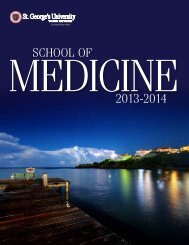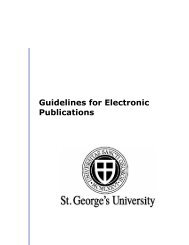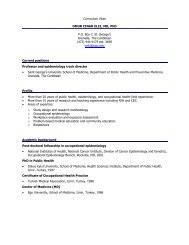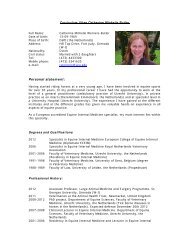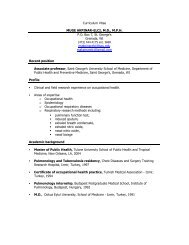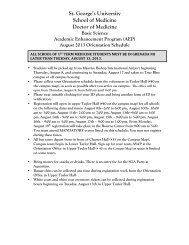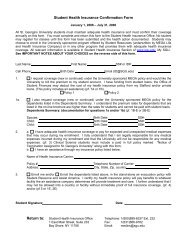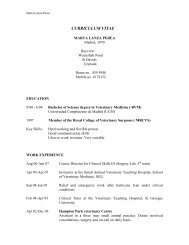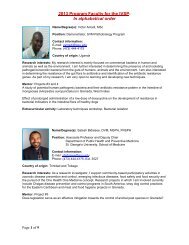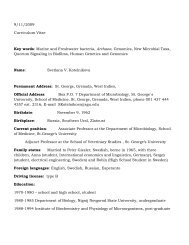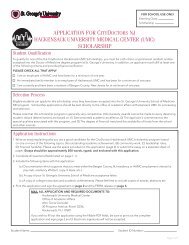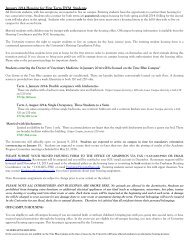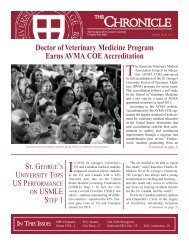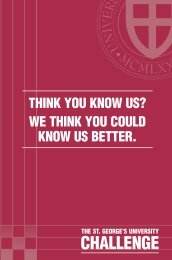SVM Catalogue 2012-2013 - St. George's University
SVM Catalogue 2012-2013 - St. George's University
SVM Catalogue 2012-2013 - St. George's University
Create successful ePaper yourself
Turn your PDF publications into a flip-book with our unique Google optimized e-Paper software.
diseases, environment, and population management<br />
are highlighted.<br />
eLeC 510<br />
Diseases of North American Wildlife II<br />
(1 cr.) (Didactic) This course focuses on common North<br />
American wildlife species from the viewpoint of a<br />
veterinarian involved in their management. The impact of<br />
transmission of wildlife diseases on human and domestic<br />
animal health are addressed and interactions between<br />
diseases, environment and population management are<br />
highlighted. Families of wildlife in part two of this course<br />
are felines, fur-bearing mammals, rodents, lagomorpha,<br />
and birds.<br />
eLeC 511<br />
Large Animal Clinical Parasitology<br />
(2 cr.) (Didactic 0.5 cr./Laboratory 0.5 cr.) The course focuses<br />
on the biology, epidemiology, and control of clinically<br />
important nematode parasites of ruminants and horses.<br />
Emphasis is placed on clinical and diagnostic issues<br />
relating to host-parasite interactions and the development<br />
of evidence-based parasite control programs. This course<br />
covers broad issues relating to host-parasite interactions,<br />
parasite epidemiology, parasite diagnosis, and the<br />
development of drug resistance.<br />
eLeC 515<br />
Wildlife Parasitology<br />
(1 cr.) (Didactic) This course introduces students to major<br />
parasites of wildlife species of North America. Parasitic<br />
life cycles are presented on major nematodes, cestodes,<br />
trematodes, blood protozoans and ectoparasites. Emphasis<br />
is placed on those common parasites which cause diseases<br />
in wildlife and/or are of major zoonotic importance.<br />
eLeC 521<br />
Wildlife Casualties<br />
(1 cr.) (Didactic) This course introduces students to the<br />
critical care of injured wildlife. With the principal aim of<br />
release of successfully treated wild animals back into<br />
their natural environment, this course links aspects of<br />
rehabilitation work with those of veterinary care. Relevant<br />
medical issues are addressed with an emphasis on ethical<br />
and legal implications of dealing with wildlife species.<br />
Year 3: Term 5 Required Courses<br />
LAMS 516<br />
Large Animal Surgery<br />
(4 cr.) (Didactic) Surgical conditions, including trauma,<br />
encountered in the food-producing and equine species are<br />
presented in terms of diagnosis, treatment, and management.<br />
LAMS 519<br />
Theriogenology<br />
(4 cr.) (Didactic 3.5 cr./Laboratory 0.5 cr.) <strong>St</strong>udents are<br />
instructed in the diseases affecting the male and female<br />
reproductive systems of the large and small domestic<br />
mammals. Causes and treatment of male and female<br />
infertility are considered, as are obstetrical procedures in<br />
normal parturition and in dystocia. Techniques involved<br />
in breeding, artificial insemination, and embryo transfers<br />
are reviewed along with methods for determination of<br />
pregnancy in various species.<br />
SAMS 513<br />
Diagnostic Imaging<br />
(3 cr.) (Didactic 2.75 cr./Laboratory 0.25 cr.) Principles of<br />
radiography are reviewed, including the various potential<br />
hazards of radiation. Radiographic imaging techniques<br />
utilized in small and large animal species are described<br />
along with other imaging methods such as ultrasonography,<br />
CT, and MRI as well as the basic principles/practices of<br />
radiation therapy. In small-group film-reading sessions,<br />
students practice proper interpretation of radiographs.<br />
SAMS 518<br />
Small Animal Surgery<br />
(5 cr.) (Didactic) The introductory portion of the<br />
course reviews principles of surgery, including asepsis,<br />
instrumentation, and surgical techniques. The remainder of<br />
the course covers the management and treatment of surgical<br />
conditions for small companion animals, including soft<br />
tissue, orthopedic, neurologic, and ophthalmic conditions.<br />
Introduction to dentistry is also covered in this course.<br />
SAMS 522<br />
Small Animal Medicine I<br />
(3 cr.) (Didactic) <strong>St</strong>udents are introduced to concepts<br />
concerning the diagnosis, treatment, and management<br />
of medical diseases in dogs and cats. Emphasis is placed<br />
on infectious diseases, dermatology, gastrointestinal,<br />
renal, respiratory, and ophthalmological diseases, and<br />
emergency/critical care medicine.<br />
School of Medicine<br />
Course Descriptions<br />
School of Veterinary Medicine Catalog <strong>2013</strong>–2014 | 53



